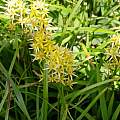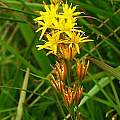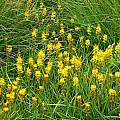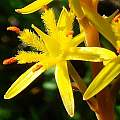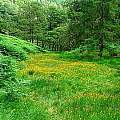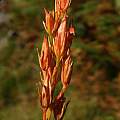Narthecium is a genus formerly included in Liliaceae and sometimes in Melanthiaceae but moved by APG II to the family Nartheciaceae. Species are perennial, growing from slender, creeping rhizomes. Leaves are mostly basal, linear. The greenish yellow to yellow flowers are arranged in a raceme at the top of the single stem and produce 1 cm long, pointed fruits with 8 mm long, elliptical seeds. Some species are commonly called bog asphodels. There is one species native to Asia (Japan), two North American species and the rest (1-5) are native to Europe.
Narthecium americanum, one of the North American species, is considered a threatened plant. It grows up to a half meter tall and is found in boggy pine-barrens and wet savannas in New Jersey, the Carolinas and Delaware. The bright yellow flowers are crowded in a raceme. Anthers are yellow.
Narthecium asiaticum is the only Asian species. Photo by Mari Kitama taken in Japan.
Narthecium californicum is found in springs, seeps, and bogs from 700-2800 m in southwestern Oregon and the North Coast Ranges and Sierra Nevada, California. Flowering in late summer, the star-like yellow flowers are in a brush-like open raceme. Basal leaves are linear and grasslike. Anthers are brick red and filaments are woolly.
Narthecium ossifragum is native to wet moorlands in Western Europe. It is commonly called the "Lancashire asphodel" because it was used as a yellow hair dye there or the "bastard asphodel". The latin name means "weak bone" and came from an incorrect belief that sheep eating the plant developed brittle bones. However it can be toxic to sheep as a result of the plant's reaction to fungal infection. Photographs taken in the Lake District by Roger Darlington; the last one shows the fruit.
